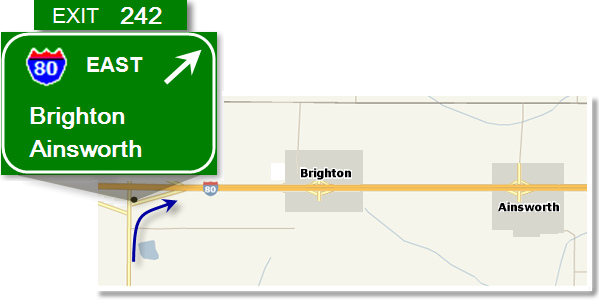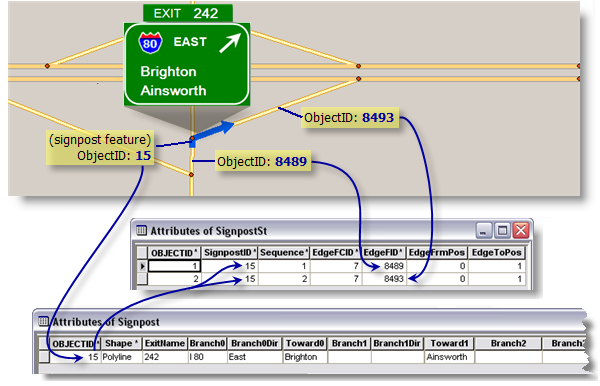Available with Network Analyst license.
Signposts provide the type of directional information found on highway road signs, such as exit numbers, connecting roads, and major destinations that can be reached along the connecting roads. If you have signpost data, you can use it to enhance the route directions generated by ArcGIS Network Analyst extension. For example, the road sign in the image below informs northbound drivers that if they take exit 242, they will enter the eastbound side of Interstate 80, which connects to Brighton and Ainsworth.

A short route along the arrow in the image above was created, and the directions, with and without signposts, are compared below. The third step in each case highlights the difference:


A driver who uses the second set of directions can avoid making a wrong turn by matching more of the information on the directions to the sign that is encountered on the road.
This signpost information for driving directions is specified by using a Signposts feature class and Signposts_Streets table. The feature class describes the text on the road sign, and the table identifies the street segments that are traversed when following directions given by the road sign.
It is possible, but not recommended, to create signposts yourself using the format described in the following sections. In either case, once the data is prepared, both the feature class and table must be specified on the Network Dataset Properties dialog box for them to be valid.
Signposts feature class
The Signposts feature class is a line feature class. In the case of a geodatabase, it must reside in the same feature dataset as the network dataset. In the case of a shapefile network dataset, it must reside in the same workspace. A Signposts feature class can support a maximum of 10 branches and 10 destinations. The table below describes the fields on a Signposts feature class that support two branches and three destinations.
| Field | Format | Description |
|---|---|---|
ObjectID | OID | Signpost ID (OID field). |
Shape | Geometry | Geometry of the signpost (line geometry). |
ExitName | Text | Exit number, for example, exit 242. |
Branch0 | Text | Name of the first street or highway at the end of a ramp, for example, I-80. |
Branch0Dir | Text | Official direction of Branch0, for example, North, South, East, or West. |
Branch0Lng | Text | Language of Branch0, for example, en, de, fr. |
Branch1 | Text | Name of the second street or highway that shares the physical road used by Branch0. If I-80 and Highway 30 shared the segment of road at the end of the ramp, Hwy 30 would be entered here. |
Branch1Dir | Text | Official direction of Branch1, for example, North, South, East, or West. |
Branch1Lng | Text | Language of Branch1. |
Toward0 | Text | First destination beyond where the ramp ends, for example, Brighton. |
Toward0Lng | Text | Language of Toward0, for example, en, de, fr. |
Toward1 | Text | Second destination beyond where the ramp ends, for example, Ainsworth. |
Toward1Lng | Text | Language of Toward1. |
Toward2 | Text | Third destination beyond where the ramp ends, for example, another city or a point of interest. |
Toward2Lng | Text | Language of Toward2. |
Signposts_Streets table
The Signposts_Streets table should reside in the same geodatabase or shapefile workspace as the network dataset. The schema for the Signposts_Streets table is as follows:
| Field | Format | Description |
|---|---|---|
ObjectID | OID | ObjectID field. |
SignpostID | Long | Foreign key to ObjectID field on signposts feature class. |
Sequence | Long | Sequence identifier for the maneuver segment. For TrueSequence maneuvers, this can be 1-K, where K is the maximum number of edges in a maneuver. For maneuvers with only first and last edges, it is 1 for the first edge, and 0 for the last. |
EdgeFCID | Long | Feature class ID corresponding to the streets feature class in the signpost maneuver sequence. |
EdgeFID | Long | Feature ID corresponding to the street feature in the signpost maneuver sequence. |
EdgeFrmPos | Double | Used to determine the street feature where the signpost maneuver sequence begins.* |
EdgeToPos | Double | Used to determine the street feature where the signpost maneuver sequence ends.* |
*Notes regarding the EdgeFrmPos and EdgeToPos values:
- For travel along the edge in the digitized direction of the line feature, the EdgeFrmPos value is less than the EdgeToPos value.
- For travel opposite the digitized direction of the line feature, the EdgeFrmPos value is greater than the EdgeToPos value.
- For line features not logically split midspan to create multiple edge elements, the EdgeFrmPos and EdgeToPos values are set to 0.0 and 1.0, respectively. Otherwise, these values are set to the fractional values where the logical splits occur for the edge element.
For best performance, it is strongly recommended that a separate attribute index is created for each of the following fields on the signpost streets table:
- SignpostID
- Sequence
- EdgeFCID
- EdgeFID
Learn more about indexing an attribute
Signpost example
The following image and attribute tables illustrate how the green sign can be modeled:

- The signpost feature (symbolized as the thick blue arrow) gives directions for a turn across two street features; therefore, two records represent the signpost in the signpost streets table.
- Since the ObjectID of the signpost feature is 15, the SignpostID for both records in the table is 15.
- The EdgeFCID refers to a system-generated feature class identifier that is automatically assigned to a feature class when it is created. The streets feature class in this example was assigned 7.
- The EdgeFID refers to the ObjectID of a unique street feature in the streets feature class.
- Since the signpost feature begins on street 8489, the Sequence value for that record is 1.
- Since the signpost feature ends on street 8493, the Sequence value is 2 (optionally, the last edge could be assigned a value of 0 instead).
- Since street 8489 was digitized from south to north—the same direction as the signpost—the EdgeFrmPos and EdgeToPosition values are 0 and 1, respectively. The same is true for street 8493. However, if the digitized direction of the street went against the signpost direction, the 0 and 1 values would be switched.